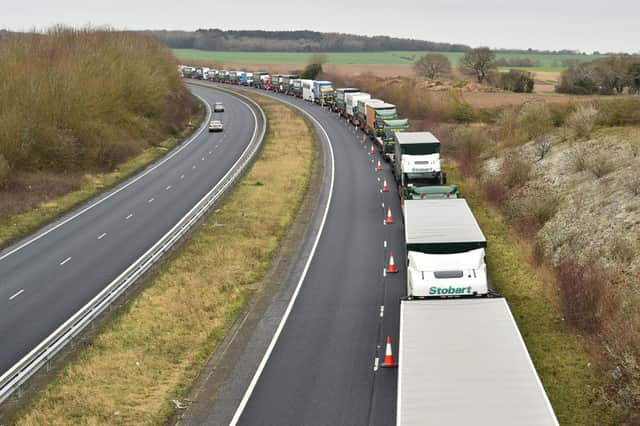A ‘Kent Access Permit’ could be brought in for lorry drivers - here’s what it means


In Kent, police will patrol the border to turn away lorries without a so-called ‘Kent Access Permit’ in an effort to ease Brexit border issues, it has been revealed.
Those without a permit would be blocked from entering Kent in a new ‘internal border.’
Advertisement
Hide AdAdvertisement
Hide AdWhat did Michael Gove say?
A de facto Brexit border is to be implemented for lorry drivers entering Kent to travel into the EU from 1 January 2021, Michael Gove has confirmed.
Minister for the Cabinet Office, Gove, said that officers will employ the use of automatic number plate recognition (ANPR) cameras as well as “other means” to block drivers without a permit.
He told MPs that the move would try to ensure that “constituents are not inconvenienced”, after warning of queues containing up to 7,000 lorries and two day delays to cross the Channel.
Gove laid out a new “worst case scenario” which states that 70 per cent of trucks might not be ready for new checks to cross the Channel. However, under questioning, Gove refused, twice, to say how many of his 50,000 “customs agents” have been recruited.
Advertisement
Hide AdAdvertisement
Hide AdFormer Deputy Prime Minister and Kent MP Damian Green said that the potential of extremely long queues of traffic would “send a chill” through the local people of Kent.
Gove replied, “We want to make sure that people use a relatively simple process in order to get what will become known as a Kent Access Permit, which means that they can then proceed smoothly, because they do have the material required.
“If they don't have the material required, then it will be the case that through policing, ANPR cameras and other means, we'll do our very best to ensure that his constituents are not inconvenienced.”
What is the Kent Access Permit?
The legislation would require any haulier using the designated roads in Kent leading to the Port of Dover and Eurotunnel to be in possession of a ‘Kent Access Permit’, also known as KAP.
Advertisement
Hide AdAdvertisement
Hide AdThe KAP would be digitally issued to drivers that have received a ‘green’ or ‘amber’ result from the smart freight (SF) service. Each KAP would be valid for 24 hours in order to cover a single trip.
Police and DVSA enforcement officers could issue penalties to hauliers heading for Dover or the Eurotunnel without one.
Travelling with a ‘red’ SF service result - which means they have been advised not to travel - or failure to use the SF portal at all, and therefore not having a valid KAP, would be a fineable offence.
What fines could be issued?
“Fines for not having a valid KAP would be levied using fixed penalty notices for UK HCV drivers, and financial penalty deposit notices for foreign drivers,” the government explained in the initial legislation proposal.
Advertisement
Hide AdAdvertisement
Hide AdFines would generally be issued on the spot, but UK drivers would have up to 28 days to pay. If a driver were to refuse to pay, then their HCV could be impounded.
It’s explained that enforcement would be taken against the driver, rather than the haulier or freight forwarder who has the formal responsibility for completing the customs paperwork.
This is due to the fact that not having a valid KAP, ignoring the Operation Brock contraflow, or driving without a valid Brock permit would be an offence committed by the driver of the vehicle.
In the initial legislation proposal, it’s suggested that fines for not having a valid KAP would be set at £300, as is the same with other Operation Brock fines.
Advertisement
Hide AdAdvertisement
Hide AdWhat is Operation Brock?
Operation Brock is the name for a series of measures implemented to improve Kent’s resilience in the event of cross-channel disruption, according to the government.
There are stages to Operation Brock which can be scaled up or down to meet demand.
In addition to M20 contraflow, lorries can also be routed to Manston Airfield, and, where required, the M26 motorway can be closed and used to queue HGVs as well.
The government states, “Drivers of lorries weighing more than 7.5 tonnes heading for Eurotunnel or the Port of Dover on the M20 should follow signs directing them onto the coastbound carriageway of the M20 between junction 8 for Maidstone and junction 9 for Ashford.
Advertisement
Hide AdAdvertisement
Hide Ad“A 30mph speed limit is in place and, in the event of disruption at the ports, lorries could be queued on this section of motorway.
“All other drivers can continue their journeys as normal. On the M20, two lanes remain open to traffic in each direction between junctions 8 and 9, using a contraflow on the London-bound carriageway, with a 50mph speed limit in place.”
A version of this article originally appeared on our sister site The Scotsman